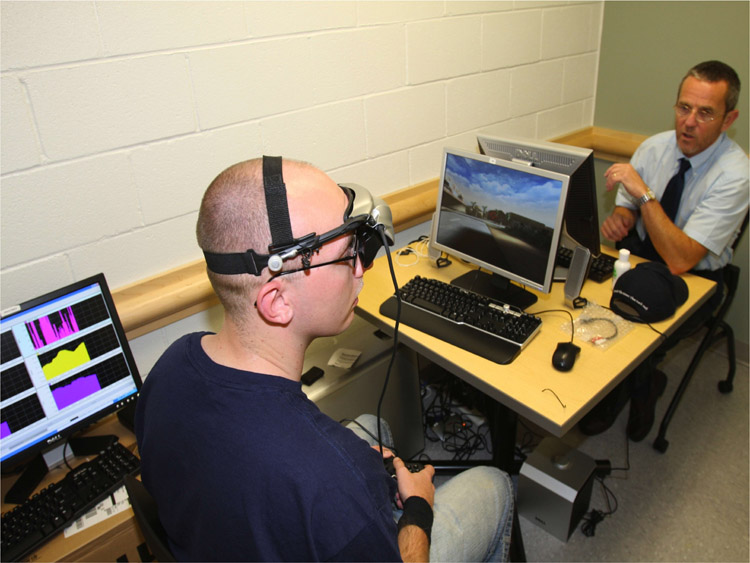
Through Operation Re-entry North Carolina, Dr. Carmen Russoniello of East Carolina University is working on developing a portable biofeedback training program that could prevent or reduce post-traumatic stress symptoms. (Photo courtesy of Dr. Carmen Russoniello.)
By Barb Ruppert
A public university in one of the most concentrated military corridors in the Nation has teamed up with DoD in a major initiative to address the post-deployment health concerns of service personnel, veterans, and their families.
With the sheer number and diverse reintegration challenges of returning personnel—and the alarming increase in the suicide rate for combat veterans—DoD and the U.S. Department of Veterans Affairs (VA) are building and strengthening civilian partnerships to expand their capabilities to meet urgent and ongoing needs.
Operation Re-entry North Carolina is a growing research and development partnership led by East Carolina University (ECU) in Greenville, NC. It was funded in September 2011 with $2.1 million for its first year through a cooperative agreement with the U.S. Army Medical Research and Materiel Command’s Telemedicine and Advanced Technology Research Center (USAMRMC TATRC).
Many ECU faculty members were already conducting military health research projects with nearby partners such as the Marine Corps Wounded Warrior Battalion and the Naval Hospital at Camp Lejeune, NC; the Warrior Transition Unit and Womack Army Medical Center at Fort Bragg, NC; and the Durham VA Medical Center and its rural outpatient network. But Dr. David Cistola, ECU Associate Dean for Research and Director of the new program, explained that Operation Re-entry North Carolina allows the university to collaborate more effectively with the military.
“It creates synergy among projects,” he said. “We’re now coordinating several common elements, such as navigating the military’s regulatory process for research studies, so each project can achieve what it couldn’t separately.”
The program was chosen for funding by TATRC after an extensive peer review process. TATRC has defined the gaps where research is needed and has worked with ECU to choose pilot projects that appear to hold the most promise for addressing these gaps.
“We asked our researchers to align their strengths with the stated needs and apply to be part of the program. With this process, as well as TATRC’s help in connecting with the many agencies in the military health care system, we hope to move quickly to making a real difference for our service members,” Cistola said.
Coordinated research areas focus on rehabilitation sciences, behavioral health, and telemedicine. Ten pilot projects were chosen for funding in this first year. Projects and their investigators include:
- “Efficacy of Heart Rate Variability Biofeedback Combined with Neurofeedback in Reducing Symptoms of PTSD”—Carmen Russoniello.
- “Essential Life Skills for Military Families—Single Service Member Version” —Elizabeth Carroll.
- “Sensory Reweighting in Trauma- or Blast-induced Dizziness”—Kristal Mills, Sherri Jones, Blaise Williams, and Leslie Allison.
- “Development of a Personal Telemedicine Device for Health Assessment and Improvement”—Carmen Russoniello.
- “Effective Use of Interactive Metronome with Marines Suffering from TBI”—Leonard Trujillo.
- “Identification of Blood microRNA Biosignature for TBI”—Baohong Zhang and Xiaoping Pan.
- “Integrated Care for Military Families”—Angela Lamson.
- “Virtual Reality-based Home Safety Inspection System”—Irene Hamrick, University of Wisconsin-Madison.
- “Heal the Hearing: From Combat to Re-entry”—Jason Yao and Gregg Givens.
- “Re-entry with Recovery: Supporting Veteran Recovery from Substance Abuse, Mental Illness, and Mild TBI”—Paul Toriello.
Some of the projects are farther along in development than others. If all goes well, Russoniello’s work on integrating biofeedback into a game that may help prevent symptoms of post-traumatic stress could be ready for field testing this year.
Mills’ team is working on a rehabilitation strategy for trauma-induced dizziness based on recent ECU findings.
“One of the main symptoms of brain injury is dizziness and difficulty with balance, but it wasn’t clear exactly what mechanism was at play here,” said Cistola. “Our research with Marines from Camp Lejeune has shown that it’s not inner ear damage, as commonly thought, but a problem with how the brain integrates this sensory input. Now we can develop treatments based on this new understanding.”
Another project closer to actual use is the work of Yao and Givens on an Internet-based portable audiometer that would allow for a full hearing evaluation of a service member in theater. Hearing loss is a common risk in the field; currently, a Soldier must be pulled from his or her unit and transported to Germany for assessment by an audiologist. With the new device, an audiologist anywhere in the world could conduct an evaluation via telemedicine. ECU holds the patent on the device, and the research team is working with TATRC to make it compatible with military requirements.
“These pilot projects are high-risk, high-reward studies that could help speed exciting ideas to the next step and, ultimately, greatly improve the care of our warfighters,” said COL Karl Friedl, TATRC Director.
Cistola noted that, as a public university, ECU has a mission to serve its region, which includes many veterans and active-duty military members.

“We must look to the future,” Cistola said. “For instance, we’re not satisfied with the kind of care we can currently offer someone with a blast-induced brain injury. Operation Re-entry North Carolina seeks to improve clinical and support capabilities.
“We feel a solemn obligation to do all we can to mobilize our expertise and resources to help those who have put their lives on the line for our country. It’s embedded in our mission and embedded in our souls.”
TATRC partners with other USAMRMC units to provide leadership in military-focused research efforts. For more information on TATRC’s research funding and collaborative opportunities, visit www.tatrc.org. For more information on Operation Re-entry North Carolina, visit http://www.ecu.edu/cs-dhs/ah/ornc.
- BARB RUPPERT is is a science and technology writer for USAMRMC TATRC. She holds a B.A. in English from the University of Virginia and an M.A. in education from Virginia Tech.







